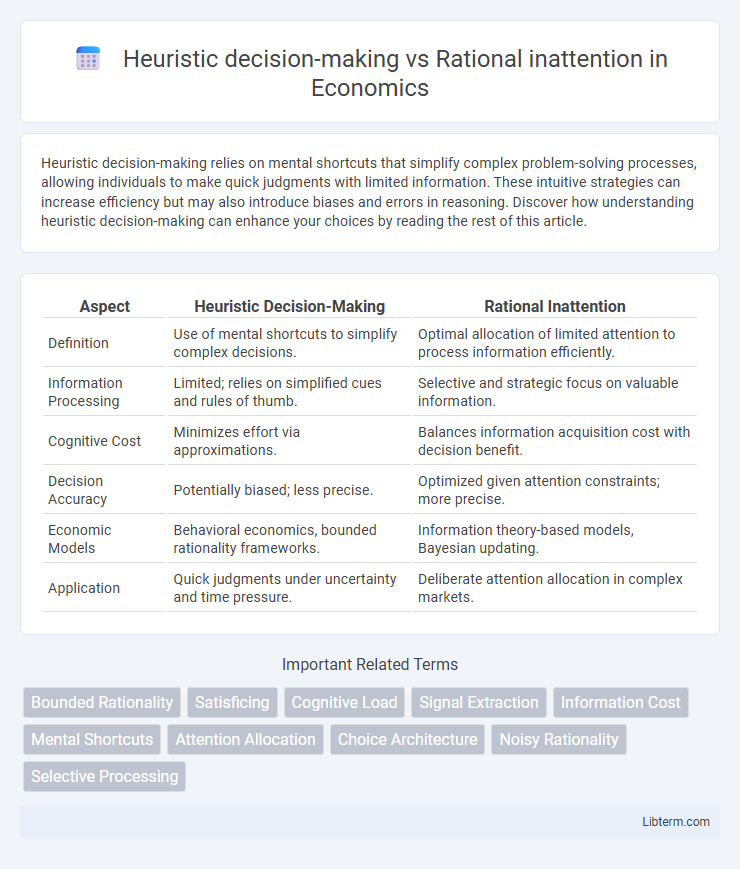Heuristic decision-making relies on mental shortcuts that simplify complex problem-solving processes, allowing individuals to make quick judgments with limited information. These intuitive strategies can increase efficiency but may also introduce biases and errors in reasoning. Discover how understanding heuristic decision-making can enhance your choices by reading the rest of this article.
Table of Comparison
| Aspect | Heuristic Decision-Making | Rational Inattention |
|---|---|---|
| Definition | Use of mental shortcuts to simplify complex decisions. | Optimal allocation of limited attention to process information efficiently. |
| Information Processing | Limited; relies on simplified cues and rules of thumb. | Selective and strategic focus on valuable information. |
| Cognitive Cost | Minimizes effort via approximations. | Balances information acquisition cost with decision benefit. |
| Decision Accuracy | Potentially biased; less precise. | Optimized given attention constraints; more precise. |
| Economic Models | Behavioral economics, bounded rationality frameworks. | Information theory-based models, Bayesian updating. |
| Application | Quick judgments under uncertainty and time pressure. | Deliberate attention allocation in complex markets. |
Understanding Heuristic Decision-Making
Heuristic decision-making relies on mental shortcuts and simplified rules to make quick, efficient judgments under limited information or time constraints. It contrasts with rational inattention, where decision-makers optimize attention allocation by weighing the cost of acquiring additional information against potential benefits. Understanding heuristic decision-making highlights the role of cognitive biases and satisficing behavior in practical, real-world decisions.
Exploring the Concept of Rational Inattention
Rational inattention explores the cognitive limitations individuals face when processing information, leading to selective attention and decision-making under constraints. Unlike heuristic decision-making, which relies on mental shortcuts to simplify complex problems, rational inattention models how agents optimally choose what information to acquire given the cost of attention. This concept is central in behavioral economics, highlighting the trade-off between information accuracy and processing effort in economic choices.
Cognitive Mechanisms Behind Quick Judgments
Heuristic decision-making relies on mental shortcuts and pattern recognition, enabling fast judgments by minimizing cognitive effort. Rational inattention involves selectively allocating limited cognitive resources to process only the most relevant information, optimizing decision efficiency under information constraints. Both mechanisms balance speed and accuracy, but heuristics prioritize immediate simplification, while rational inattention emphasizes strategic information filtering.
Information Processing Limits in Human Behavior
Heuristic decision-making relies on mental shortcuts to overcome information processing limits, enabling faster judgments under cognitive constraints. Rational inattention theory models how individuals allocate limited attention by selectively filtering information to optimize decision outcomes. Both frameworks address human behavior by emphasizing the trade-off between cognitive capacity and the complexity of environmental information.
Key Differences Between Heuristic and Rational Inattention
Heuristic decision-making relies on simple, efficient rules or mental shortcuts to quickly process information and make decisions, often in the face of complexity or limited cognitive resources. Rational inattention, in contrast, models decision-making as an optimization problem where individuals allocate limited attention strategically to process only the most relevant information, minimizing cognitive costs while maximizing expected utility. The key difference lies in heuristics being rule-based and fast but sometimes biased, whereas rational inattention involves deliberate information filtering under cognitive constraints to achieve optimal decisions.
Real-World Examples: Heuristics vs Rational Inattention
Heuristic decision-making involves using mental shortcuts to quickly solve problems, such as a doctor diagnosing common symptoms without exhaustive tests, whereas rational inattention describes individuals who deliberately ignore some information due to cognitive costs, like investors who focus only on key financial indicators and overlook minor market data. In real-world scenarios, consumers choosing a product based on brand familiarity demonstrate heuristics, while drivers selectively attending to essential traffic signals exemplify rational inattention. Both approaches balance cognitive effort and decision quality, with heuristics relying on experience and rational inattention on optimal information filtering.
Advantages and Limitations of Heuristic Approaches
Heuristic decision-making offers the advantage of speed and efficiency by simplifying complex problems using mental shortcuts, making it highly effective in environments with limited information or time constraints. However, these approaches are prone to cognitive biases and errors, such as overconfidence and anchoring, which can compromise decision accuracy. While heuristics facilitate quick judgments, their limitations include reduced adaptability and potential neglect of relevant data, contrasting with the more deliberate and data-intensive processes emphasized in rational inattention models.
Costs and Benefits of Rational Inattention
Rational inattention involves allocating limited cognitive resources efficiently by selectively processing information, which reduces the costs of acquiring and analyzing data compared to exhaustive heuristics. The primary benefit lies in minimizing mental effort and time spent on decision-making while maintaining satisfactory accuracy, especially in complex or information-rich environments. However, the cost includes potential overlooking of crucial details, leading to suboptimal decisions when important information is ignored due to cognitive constraints.
When to Apply Heuristics or Rational Inattention Strategies
Heuristic decision-making is best applied in environments with high complexity and limited time, enabling fast, reasonably accurate judgments by relying on mental shortcuts. Rational inattention strategies are optimal when acquiring perfect information is costly or impractical, allowing decision-makers to selectively process relevant data while ignoring less critical inputs. Evaluating the trade-off between decision urgency, information costs, and cognitive resources guides the effective choice between heuristics and rational inattention.
Implications for Behavioral Economics and Policy
Heuristic decision-making simplifies complex choices by using mental shortcuts, often leading to systematic biases, while rational inattention models decision-makers as optimizing information acquisition under cognitive constraints, impacting how individuals allocate attention and process information. Behavioral economics integrates these concepts by explaining deviations from classical rationality, influencing policy designs that account for bounded rationality and information processing limits. Policies leveraging insights from both approaches improve outcomes by tailoring interventions that reduce cognitive overload and enhance decision quality through better information presentation and nudges.
Heuristic decision-making Infographic

 libterm.com
libterm.com